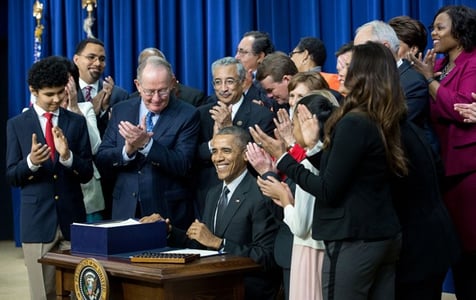
Whether it’s an infant cooing in response to a teacher’s gentle voice in an Early Head Start classroom or a second grader delighting in their teacher’s positive feedback in an elementary school classroom down the street, interactions matter in every education setting across the country.
With this in mind, Teachstone celebrates the dedication and bipartisan work of the many education advocates and government officials who worked tirelessly to reauthorize the Elementary and Secondary Education Act with President Obama’s signing of the Every Student Succeeds Act (ESSA) last week.
As an organization driven to ensure all children and students—regardless of age or grade—are in classrooms with warm, responsive, organized, and instructionally supportive interactions, Teachstone embraces the emphasis on alignment across the age and grade levels in ESSA. With our full range of age level tools to support teachers of infants through 12th graders, Teachstone is poised to support states in their efforts to improve school readiness of low income and disadvantaged children and improve transitions into the K-12 system, as required in the ESSA’s Preschool Development Grants program.
We are thrilled to share this excellent summary of the ESSA from Rachel Demma, Policy Director of the Early Care and Education Consortium (ECEC), of which Teachstone is a proud member. ECEC is the nation’s leading non-profit alliance of high quality multi-state/multi-site community child care providers (both non-profit and tax-paying), key state child care associations, and national educational services provider organizations.
ELEMENTARY AND SECONDARY EDUCATION ACT: EARLY CARE AND LEARNING IN THE EVERY STUDENT SUCCEEDS ACT
On December 10th, President Obama signed into law the Every Student Succeeds Act, Congress’ dramatic revision of the Elementary and Secondary Education Act, previously No Child Left Behind. Here’s what you need to know about early care and learning in the new law.
Early care and learning are woven throughout provisions within the new legislation, including those addressing Title I, the Ready to Learn literacy program, Promise Neighborhoods, and charter schools. In addition, language now refers to an educational “pipeline” that extends from early childhood throughout post-secondary education. Section 854B emphasizes Congress’ view that state decisions regarding early learning and child care should be independent of federal choice for parents through a mixed delivery system of services so parents can determine the right early learning and child care option for their children.
However, the centerpiece of early care and learning in the new law is under the umbrella of Preschool Development Grants, found in Section 9212. This set of provisions actually refers to the coordination of comprehensive mixed delivery systems of all early care and learning programs within states, including all federally, state, and privately funded programs serving low and moderate-income children. This encompasses child care, Early Head Start and Head Start, licensed family and center-based child care programs, public schools, and community-based organizations.
Here is a brief summary of the new Preschool Development Grants program:
- It will be jointly administered by the Secretaries of Education and Health and Human Services (HHS); however, the program will be housed by HHS.
- All states are eligible to apply for competitive 1-year grants to support strategic planning and implementation of their state early childhood mixed delivery systems, focused on improving the school readiness of “low-income and disadvantaged” children and improving transitions into the K-12 system.
- States must commit to matching funding at 30% of the grant award.
- States are eligible to apply for a 3-year renewal grant.
- Governors will identify a state entity to administer the grant.
- State strategic plans should address how states plan to use existing resources in order to:
- Align and strengthen the delivery of existing programs by more efficiently using federal, state, local and private resources;
- Coordinate delivery models and funding streams;
- Improve both participation and program quality while maintaining the availability of services; and
- Improve parental choice among existing programs.
- State grant activities must include:
- A periodic statewide needs assessment;
- Collaboration, coordination, and partnership opportunities that improve both program quality, service delivery, and program participation;
- Alignment with existing early childhood statewide initiatives, including governance among State Advisory Councils, as well as the Child and Development Block Grant (CCDBG) Act of 2014.
- Maximizing parental choice and knowledge of mixed delivery system programs and providers; and
- Sharing best practices among state programs and providers.
- These grants will not be subject to any federal mandates regarding specific requirements around standards, curriculum, and assessment, measures or indicators of quality, teacher and staff qualifications and salaries, program duration (length of day and year), or class sizes and ratios.
- States are encouraged to use subgrants to carry out their strategic plan activities. There is a limit of 60% of funding to support subgrants within a state’s first year of their grant renewal, and 75% in the second year of renewal.
- The House has approved an appropriation of $250m to support this program from FY 2017-2020.
With the passage of the Every Student Succeeds Act, complemented by last year’s reauthorization of the Child Care and Development Block Grant (CCDBG), states are poised to leverage new statutory reach to align state systems and expand access to high-quality early care and learning programs, including state-funded preschool for children from low- and moderate-income families. However, both federal and state resources remain critical in order to maximize the impact of both newly minted laws. With adequate levels of investment behind them, these key legislative packages may open new inroads that significantly advance how we support America’s workforce of today and tomorrow.
